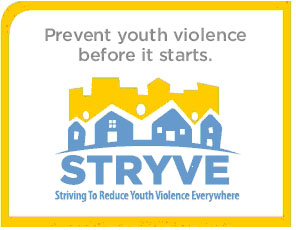 By Linda McGlone, MPH, STRYVE Coordinator, Monterey County Health Department, California
By Linda McGlone, MPH, STRYVE Coordinator, Monterey County Health Department, California
Looking at youth violence through a public health lens, the Monterey County Health Department contributed to violence reduction by offering their skills in data, strategic planning, and the public health approach.
In 2011, Salinas, California was a small city with a big city problem: gang violence. The violent crime rate for Salinas was 732.5 crimes per 100,000 residents – higher than Los Angeles’ rate of 522.4. For decades, gang-related shootings caused most of the city’s violent injuries. Monterey County had the highest rate of youth homicides in California in 2009, 2010, 2012, and 2013. Salinas is a city of 150,854 residents, 75% of whom are Hispanic or Latino. This is a young community, with a high percentage of families living below the federal poverty level, organizing to become a healthy and thriving community. The Monterey County Health Department (MCHD) recognized youth violence as a public health problem, and we saw that primary prevention was lacking from the community’s response. How could this perspective gain traction in a discussion led largely by law enforcement?
MCHD received a STRYVE grant from the Centers for Disease Control and Prevention (CDC) in 2011 to prevent youth violence, with prevention of teen dating violence added in 2016. The CDC’s goal was to increase the capacity of the local health department (LHD) and the violence reduction coalition to prevent youth violence using a public health approach. To begin, MHCD joined the city’s existing multisector coalition, which was led by the mayor and a county supervisor and included representatives from non-profits, school districts, law enforcement, the faith community, and many others. The second task was to help update the city’s comprehensive strategic plan using the health department’s skills in data analysis and strategic planning. The third step was to select strategies based on risk and protective factors related to youth violence. Our current strategies consist of Crime Prevention through Environmental Design (CPTED), Strengthening Families, and Safe Dates. Lastly, CDC guided the LHDs through the development of implementation, evaluation and sustainability plans. The youth violence prevention initiative is led by the city, with support from the health department; it encompasses the entire city, with a focus on one area that is disproportionately affected by violence.
Salinas has seen the rate of violent crime and violent assaults on youth decline significantly over the last six years; however, homicides have increased. These results are supported by short-term outcomes focusing on awareness, behavioral and environmental changes, strategy reach, and fidelity implementation of evidence-based programs. Intermediate outcomes consist of shared risk and protective factors, affecting multiple forms of violence. We are tracking changes in the risk factors of violent social problem-solving skills and neighborhood support and cohesion, along with the protective factor of family support and connectedness. Desired long-term outcomes are a decreased rate of domestic violence among youth, a decreased rate of violent assaults of youth, and a decreased number and density of violent crime hotspots using GIS mapping. Anecdotally, we are hearing from youth that the city is safer, but unfortunately the parents do not share this perception.
Over the last seven years we have overcome skepticism regarding the LHD’s contribution to violence reduction by offering our skills in data, strategic planning, and use of the public health approach. Our contribution is best exemplified by MCHD’s access to police department data for analysis and tracking changes in crime. We have also learned to build on existing resources by subcontracting with selected organizations. Through this approach we have gained access to often hard-to-reach populations, and we have tapped into existing systems that connect with those groups. Funding is offered as “seed money” to purchase materials and train staff to enhance sustainability. The implementation of the Safe Dates program through MCHD’s teen pregnancy program demonstrates the impact of this approach, with a reach of 2,035 students in five schools in the second year. Our health department succeeded with additional guidance and funding from the CDC, but a similar initiative could be replicated. In our experience, the most important elements for success are access to skilled public health staff, including epidemiologists; a strong coalition supported by elected officials; commitment to build on existing resources; funding for training in EBPs matched to local risk and protective factors; and a full-time coordinator position.
See all references here: http://www.nacchostories.org/wp-content/uploads/Youth-Violence-References.pdf.


